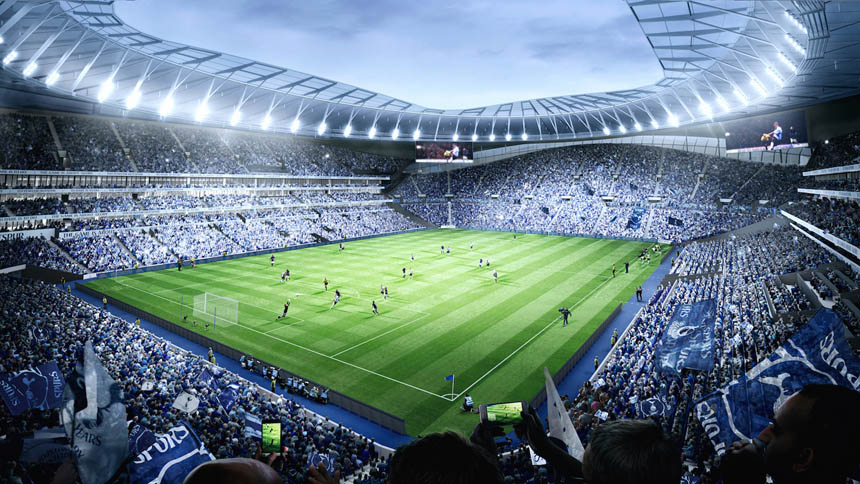Not only are Spurs hunting down Leicester City in the chase for the Premier League title, Tottenham is scoring property goals too.
A football club is often tagged as being ‘at the heart of the community’. It is not always the case, but Premier League side Tottenham Hotspur is proving a lead player in the regeneration of its north London homeland – a testimony to the power of sport, in partnership with public and private enterprises, to make a striking social and economic difference.
Tottenham Hotspur chairman Daniel Levy said: “We are progressing what we firmly believe will be one of the finest stadiums anywhere in the world – a vital step for the continued success of the club and importantly the development which kick-starts the regeneration of north Tottenham.”
When Levy first came to the club he stated his three priorities were to invest in the first team, create a new world-class training facility and deliver an “iconic, increased capacity stadium”.
Spurs are pushing hard for the Premier League title, driven by the talent of young England stars such as Harry Kane and Dele Alli, who both scored two goals in a 4-0 win over Stoke City last night to close the gap on league leaders Leicester City to five points.
The Spurs training centre opened in 2012 and the 61,000-seat stadium, which will also host NFL games, is set to be completed in time for the start of the 2018-19 season.
“The new scheme will have up to 585 new homes. The delivery of the new homes is the final phase of the development given that these homes are being built on the land currently occupied by the existing stadium and we expect construction of these to start once the new stadium is open,” said Levy.
The Northumberland Development Project, as it is known, will create 3,700 jobs and see nearly £300m spent in the area a year, up from £120m today.
“This is far more than just a sporting project and the benefits in Tottenham will be felt for generations to come.”
 Levy says the football club has never lost touch with its roots, establishing the Tottenham Hotspur Foundation – a registered charity that uses sport to improve the quality of life for people of all ages and abilities.
Levy says the football club has never lost touch with its roots, establishing the Tottenham Hotspur Foundation – a registered charity that uses sport to improve the quality of life for people of all ages and abilities.
“I believe we have a duty as a club to improve the lives of the people around us and we have absolutely embraced that philosophy,” said Levy.
“We would not be making a £500m plus investment into one of the most deprived parts of London without a wider plan in place to maximise the benefits that would be delivered. We are the catalyst for change and are making the single most important intervention into the area, but a football club can only do so much. We are delighted to have now seen committed action from both Haringey Council and the Mayor of London to support further investment and development in the area. We set out to build a new stadium and we find ourselves playing the key role in regenerating a neighbourhood.”
Levy says that unfortunately it took the 2011 Tottenham riots to galvanise action and highlight the need to regenerate the area. The football chairman admits there have been frustrations along the way, but believes the club’s relationship with the local community has got stronger.
“Every time we were at a planning committee the support we received was from right across the community. We are part of the very fabric of the area and proud to be part of significant place-change.”
As well as creating new homes and jobs, bold, innovative, sustainable architecture is a key tenet of the project – the need to look good as well as feel right.
“We have been able to embrace the absolute best of stadia design from around the world along with outstanding designs for the residential, public space, hotel, museum and retail buildings and I am extremely proud to be able to bring that to the heart of Tottenham,” said Levy.
“Tottenham used to be one of the finest addresses in London and it will be so again. We have superb transport connections, a thriving community and ambitious regeneration plans supported by Haringey Council and the Mayor of London as well as ourselves.”
“We always wanted our Northumberland Development Project to be the catalyst for wider change around us and change that really benefits local people. There will be new homes, new jobs, new shops and new places to visit. We are all proud at this club to be working to achieve this and to be working at the heart of the community.”
The ambition is to build 10,000 new homes and create 5,000 new jobs in Tottenham by 2025.
“The scale of our ambition in Tottenham shouldn’t be underestimated. In the next 10 years alone, we plan to bring 10,000 new homes, 5,000 new jobs and nearly one million square feet of commercial space, alongside the huge improvements to schools, health facilities and transport infrastructure that will make Tottenham one of London’s best places to live and work,” said councillor Alan Strickland, Haringey cabinet member of regeneration and housing.
“Delivering on such a scale demands solid partnerships at local, regional and national government, as well as with the private sector, to get development off the ground. That’s exactly what our Housing Zone will do: pooling resources between the council and Greater London Authority; bringing together planning teams to cut unnecessary red tape; providing expert design and technical support; and working together to land the best development partners.”